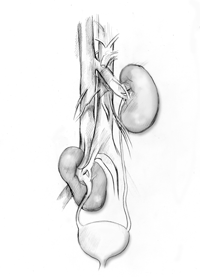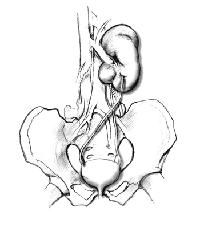Ectopic Kidney
On this page:
What is an ectopic kidney?
An ectopic kidney is a birth defect in which a kidney is located in an abnormal position. In most cases, people with an ectopic kidney have no complaints. In other cases, the ectopic kidney may create urinary problems, such as urine blockage, infection, or urinary stones. Researchers estimate that ectopic kidney occurs once in every 1,000 births.
[Top]
What are the kidneys?
Kidneys are bean-shaped organs, each about the size of your fist. Most people have two kidneys located near the middle of the back, just below the rib cage. The kidneys filter wastes and extra fluid from your blood. The wastes and extra fluid become urine, which drains from the kidneys to the bladder through tubes called ureters. Urine is stored in the bladder until it is released from the body when you urinate.
[Top]
What causes an ectopic kidney?
During fetal development, a baby’s kidneys first appear as buds inside the pelvis, near the bladder. As the fetal kidneys develop, they climb gradually toward their normal position near the rib cage in the back. Sometimes, one of the kidneys fails to make the climb. It may stop after making part of the climb. Or it may remain in the pelvis. Rarely does a child have two ectopic kidneys.

An ectopic kidney may remain in the pelvis, close to the bladder.

An ectopic kidney may cross over and become fused with the other kidney.
Some kidneys climb toward the rib cage, but one may cross over so that both kidneys are on the same side of the body. When a crossover occurs, the two kidneys may grow together and become fused.
[Top]
What are the symptoms of an ectopic kidney?
An ectopic kidney may not cause any symptoms and may function normally, even though it is not in its usual position. Many people have an ectopic kidney and do not discover it until they have tests done for other reasons. Sometimes, a doctor may discover an ectopic kidney after feeling a lump in the abdomen during an examination. In other cases, an ectopic kidney may cause abdominal pain or urinary problems.
[Top]
What are the possible complications of an ectopic kidney?
When a kidney is out of the normal position, drainage problems are likely. Sometimes, urine can even flow backwards from the bladder to the kidney, a problem called vesicoureteral reflux, or simply reflux. Abnormal urine flow can set the stage for a number of problems.
Infection. Normally, urine flow washes out bacteria and keeps them from growing in the kidneys and urinary tract. When a kidney is out of the normal position, urine may get trapped in the ureter or in the kidney itself. Urine that remains in the urinary tract gives bacteria the chance to grow and spread. Symptoms of a urinary tract infection include frequent or painful urination, back or abdominal pain, fever, and chills. The urine may be cloudy or have an unusual smell. Stones. Urinary stones form from substances found in the urine, such as calcium and oxalate. Urine that remains too long in the urinary tract increases the risk that these substances will have time to form stones. Symptoms of urinary stones include extreme pain in the back, side, or pelvis; blood in the urine; fever or chills; vomiting; and burning during urination. Kidney failure. If urine backs up all the way to the kidneys, damage to the kidneys can occur. As a result, the kidneys can’t filter wastes and extra fluid from the blood. Symptoms of kidney failure include swelling in the legs or abdomen, feeling very tired, headaches, or nausea. If total kidney failure occurs, you will need dialysis or a kidney transplant. Total kidney failure
happens only when both kidneys are damaged. One ectopic kidney, even when it has no function, won’t cause kidney failure. Trauma. If the ectopic kidney is in the lower abdomen, or pelvis, it may be susceptible to injury from blunt trauma. People with ectopic kidney who want to participate in body contact sports may wish to wear protective gear.
[Top]
What tests will the doctor order?
Your doctor can get the most information about your condition by looking at pictures of the ectopic kidney. Several different imaging tests are available.
Ultrasound. During an ultrasound examination, a medical technician will glide a device called a transducer over your skin—either on your side, your abdomen, or your pelvis—depending on the location of the kidney. The transducer sends harmless sound waves into your body. The sound waves bounce off your kidney and back to the transducer. The equipment reads the sound waves and creates a black and white image of the kidney on a television screen. X ray. Your doctor may use conventional x-ray equipment to perform an intravenous pyelogram (IVP) or a voiding cystourethrogram (VCUG). In an IVP, a special dye is injected into a vein, usually in the arm. The radiologist takes a series of snapshots as the dye circulates through the blood and reaches the kidneys. The structures of the kidneys show up on the x rays as the dye is filtered from the blood and passes through the kidneys to the ureters. An IVP can show whether urine is backing up into the ectopic kidney. In children, ultrasounds are usually done instead of IVPs.
In a VCUG, a thin hollow tube called a catheter is placed into the bladder so that it can be filled with x-ray contrast material. X rays are then taken as the patient urinates. The VCUG gives information about the bladder and reveals whether urine is backing up toward the kidneys during urination. Nuclear scan. In a nuclear scan, a small amount of a radioactive drug is injected into a vein, and pictures are taken of the kidney over a period of time after the injection. Sometimes a diuretic medicine is also given to increase urine flow. This test can reveal whether the ureters—tubes that drain urine from the kidneys—are blocked and how well the kidneys work. Sometimes, a nuclear scan may be done to find the location of an ectopic kidney. Computerized tomography (CT) scan. A CT scan uses multiple x-ray images to create a cross-section view of your body on a computer screen. You will lie on a table that passes through a doughnut-shaped machine where the scanning takes place. CT scans aren’t usually needed in the evaluation of an ectopic kidney, but they may be done in a few cases. Magnetic resonance imaging (MRI). MRI technology uses radio waves and magnets to create pictures of internal organs. No exposure to radiation is required. With most MRI machines, you lie on a table that slides into a tunnel that may be open-ended or closed at one end. Some newer machines are designed to allow you to lie in a more open space. Like CT scans, MRIs are rarely needed to evaluate an ectopic kidney.
In addition to imaging tests, the doctor may order blood tests to determine how well your kidneys are working. These tests are almost always normal in patients with an ectopic kidney, even if it is badly damaged, because the other kidney usually has completely
normal function.
[Top]
What are the treatments for an ectopic kidney?
If your urinary function is normal and the doctor finds no blockage, no treatment for ectopic kidney is needed. Your doctor should continue to monitor your condition in case a change occurs.
If tests show that obstruction is present, you may need surgery to correct the position
of the kidney to allow for better drainage of urine. To correct reflux, the surgeon may reattach the ureter to the bladder so that urine can’t reflux into the kidney.
If extensive kidney damage has occurred, the surgeon may need to remove the kidney.
As long as the other kidney is working properly, losing one kidney is not a problem.
Many people live a normal life after donating a kidney for transplant. Some people are even born with only one kidney and lead full, healthy lives without discovering
their condition.
With the right testing and treatment, if needed, an ectopic kidney should cause no serious long-term health problems.
[Top]
Hope through Research
Researchers from universities and Government agencies are working to understand the causes of kidney and urinary tract birth defects and to find more effective treatments. Through its Pediatric Urology Program, the National Institute of Diabetes and Digestive and Kidney Diseases funds research into bladder and urinary tract development. Additionally, the Eunice Kennedy Shriver National Institute of Child Health and Human Development has established the Birth Defects Initiative to study the genetic and molecular mechanisms underlying the developmental processes of the fetus.
[Top]
For More Information
American Society of Pediatric Nephrology
3400 Research Forest Drive, Suite B
The Woodlands, TX 77381
Phone: 281–419–0052
Fax: 281–419–0082
Email: info@aspneph.com
Internet: www.aspneph.com
American Urological Association Foundation
1000 Corporate Boulevard, Suite 410
Linthicum, MD 21090
Phone: 1–866–RING–AUA (746–4282) or 410–689–3700
Email: patienteducation@auafoundation.org
Internet: www.auafoundation.org
www.UrologyHealth.org
March of Dimes
1275 Mamaroneck Avenue
White Plains, NY 10605
Phone: 914–997–4488
Email: askus@marchofdimes.com
Internet: www.marchofdimes.com
Eunice Kennedy Shriver National Institute of Child Health and Human Development
Information Resource Center
P.O. Box 3006
Rockville, MD 20847
Phone: 1–800–370–2943
Email: NICHDInformationResourceCenter@mail.nih.gov
Internet: www.nichd.nih.gov
[Top]
You may also find additional information on this topic using the following databases:
The NIDDK Reference Collection is a collection of thousands of materials produced for patients and health care professionals, including fact sheets, brochures, and audiovisual materials. Visit www.catalog.niddk.nih.gov/resources.
MedlinePlus brings together a wealth of information from the National Library of Medicine, the National Institutes of Health, and other government agencies and health-related organizations. MedlinePlus offers easy access to medical journal articles, a medical dictionary and medical encyclopedia, health information in Spanish, hospital and physician directories, drug and supplement lists, interactive patient tutorials, links to hundreds of clinical trials, and the latest health news. Visit www.medlineplus.gov.
National Kidney and Urologic Diseases Information Clearinghouse
3 Information Way
Bethesda, MD 20892–3580
Phone: 1–800–891–5390
TTY: 1–866–569–1162
Fax: 703–738–4929
Email: nkudic@info.niddk.nih.gov
Internet: www.kidney.niddk.nih.gov
The National Kidney and Urologic Diseases Information Clearinghouse (NKUDIC) is a service of the National Institute of Diabetes and Digestive and Kidney Diseases (NIDDK). The NIDDK is part of the National Institutes of Health of the U.S. Department of Health and Human Services. Established in 1987, the Clearinghouse provides information about diseases of the kidneys and urologic system to people with kidney and urologic disorders and to their families, health care professionals, and the public. The NKUDIC answers inquiries, develops and distributes publications, and works closely with professional and patient organizations and Government agencies to coordinate resources about kidney and urologic diseases.
Publications produced by the Clearinghouse are carefully reviewed by both NIDDK scientists and outside experts. The NKUDIC would like to thank the following members of the American Society of Pediatric Nephrology Clinical Affairs Committee for their review of this fact sheet: Maria Ferris, M.D.; Barbara Fivush, M.D.; Joseph Flynn, M.D.; Ann Guillot, M.D.; Tej Mattoo, M.D.; Cynthia Pan, M.D.; Jeff Saland, M.D.; and Steve Wassner, M.D.
This publication is not copyrighted. The Clearinghouse encourages users of this publication to duplicate and distribute as many copies as desired.
NIH Publication No. 07–5869
April 2007
[Top]
|






